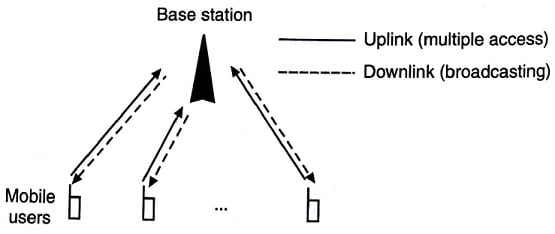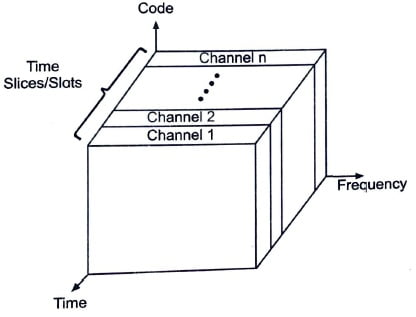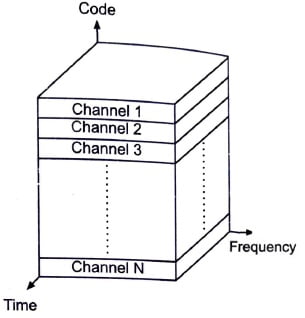Table of Contents
Multiple Access Techniques
Multiple Access Techniques: Multiple access is a signal transmission situation in which two or more user wish to simultaneously communicate with each other using the same propagation channel. This is precisely the uplink transmission situation in a wireless communication system. In the uplink or reverse channel, multiple users will want to transmit information simultaneously. Without proper coordination among the transmitting users, collisions will occur when two or more users transmit simultaneously. Access methods that incur collision are referred to as random access and variants of random access.
Multiple access Techniques or strategies based on orthogonality among the competing transmissions are collision-free. Orthogonality can be in the form of frequency division, time division, or code division. Techniques with built-in conflict resolution capability presented in this post are f frequency-division multiple access (FDMA), time-division multiple access (TDMA) and Code division multiple access (CDMA).
The radio spectrum is shared by the mobile users simultaneously. The sharing may be based on frequency, time, and code. The wireless telephony applies duplexing technique where talking and listening is enabled at a time. For example frequency division duplexing (FDD) offers two bands of frequencies for every user.
The simplex channel consists of a forward and a reverse channels and hence each duplex channel consists of one simplex channel. These forward and reverse channels are separated with a frequency band in the entire system.
On the other hand, time division duplexing known as TDD make use of time instead of frequency to have the same forward and reverse channels. Both FDD and TDD schemes have advantages and disadvantages. The multiple access schemes with any one of these techniques are used for wireless communications.
Multiple Access in a Radio Cell
In each radio cell, the transmission from the base station in the downlink can be heard by each and every mobile user in the cell. For this reason, this mode of transmission is referred to as broadcasting. On the other hand, transmissions from the mobile users in the uplink to the base station are many-to-one and are referred to as multiple access. The figure shown below illustrates the uplink/downlink transmission situations.

Transmission in the uplink mode have the following properties:
- Multiple mobile users want to access the common resource (base station) simultaneously.
- If the transmission from two or more users arrives at the base station receiver at the same time, there will be destructive interference, unless the multiple arriving signals are mutually orthogonal.
- Orthogonality between two signals x_{i}(t) and x_{j}(t), t\in [0,T], means that their inner product over the signaling interval vanishes.
Mathematically, this means that
\int_{0}^{T}x_{i}(t)x_{j}(t)dt=0 for i ≠ j
The key element in multiple access is to make the transmitted signals from the different users orthogonal to each other. This raises the fundamental question of how this orthogonality condition should be mechanized.
Different Multiple Access Schemes (Techniques)
The important multiple access schemes used are
- Frequency division multiple access (FDMA)
- Time division multiple access (TDMA)
- Code division multiple access (CDMA)
Frequency Division Multiple Access (FDMA)
In a wireless environment, individual users are allotted individual channels. The channels are frequency band is unique for each user/subscriber. The entire allowed radio spectrum is divided into many slices of frequency bands and each band or channel is allocated to each user. The allocation of radio channels can also be done on-demand basis.
In conventional telephonic systems, bidirectional communication is possible simultaneously and it is essential for cellular communication also. Such a simultaneous talk and listen facility is known as duplexing. Under frequency division multiplexing, duplexing is done using frequency and hence it is termed as frequency division duplexing (FDD).
In FDD, the duplex channel contains dual simplex channels namely forward and reverse channel as shown in figure below.

The forward frequency band provides radio traffic from the base station (BTS) to the mobile unit whereas the reverse frequency radio band provides radio traffic from the mobile unit to the base station. A duplexer device is kept in a mobile unit and base station for enabling simultaneous conversation.
Important Point: The separation in frequency between the forward and reverse channel is constant in the entire system for all the channels.

The above figure shows, the principle of FDMA multiplexing scheme is shown where the entire bandwidth is divided in frequency slices and assigned to every user.
Salient Features of FDMA Scheme
- FDMA requires proper filtering at receiver side to avoid adjacent channel interference (ACI).
- In FDMA scheme, if a channel is not in use it will be idle and it will not be used by some other user. Hence, there is a chance of resource wastage.
- FDMA channel can handle one phone circuit at a time.
- Complexity is less.
- Narrow bandwidth.
- If voice channel are assigned in FDMA, then, the mobile unit and base station start transmitting simultaneously.
Non-linear Effects in FDMA Scheme of Multiplexing
In this multiplexing scheme, the same antenna at the base station is shared by several radio channels. The power amplifiers are operated near the saturation region for getting maximum possible power efficiency and it is non-linear. These non-linearities cause the spreading of signals over the entire frequency domain resulting in intermodulation (IM) frequency generation. It will enhance interferences in actual signal and intermodulation must be minimized.
Time Division Multiple Access (TDMA)
In time division duplexing utilizes time instead of frequency. Several users share the time slots of the entire time available. Each user is allocated a time slot in which it can access the channel.
Each duplex channel (TDD) has individual time slots for forward and reverse time slots to have bidirectional communication. A TDD slot on the same frequency is shown in the figure below.

This TDD mode enables every transceiver (transmitter and receiver) to operate as a transmitter or receiver. The TDD mode is generally used in cordless phones. The principle of the TDMA multiplexing scheme is shown in figure 11.42 (b).

In the TDMA system, the entire radio spectrum divided into time slots where a single user is allowed to use the radio channel in a time slot. In TDMA digital data transmission and digital modulation are allowed. Many users can access their channels in their respective time slots. The transmission from several users is interlaced into a single frame as shown in the figure below.

In this format, the preamble field contains the synchronization and address informations. The guard bits are used to allow synchronization of the different receivers between various
frames and time slots. It is assumed that there are ‘N’ number of time slots for ‘N’ number of users so that each user can access the channel in their allowed time slot.
Salient Features of TDMA
Each user in TDMA multiple access scheme shares same carrier frequency but with non overlapping time slots.
Code Division Multiple Access (CDMA)
In CDMA technique many users share the same carrier frequency (fe). The narrow band message signal is also multiplexed with a spreading signal of larger bandwidth. This spreading signal is actually a pseudo noise code sequence and it has higher chip rate than the data rate of the message signal.
Since same channel is shared by several users, there may be a problem of near far effect. In CDMA, the main advantage when compared to other multiple access schemes is reduced level of interference. Since each user/subscriber is allocated an individual pseudo random codeword that is orthogonal to all other codewords of remaining users at the receiving end the receiver selectivity tunes to receive the intended signal of the user. Proper power control measures are done in CDMA to avoid near far problems.

Salient features of CDMA multiple access scheme
- If the spreading sequences are not exactly orthogonal from one user and to another user there may be a chance of self-jamming problem in CDMA. Hence this spreading sequence or pseudo random noise code has to be carefully planned and then it should be multiplied with the message signal.
- Radio signal strength indicator (RSSI) is being used in CDMA to have better power control.
- CDMA has better soft capacity limit than TDMA and FDMA methods.
- CDMA has less interference problems due to allocation of unique codes to each use and this multiple access technique is applied for defence areas than other multiple access techniques.
In satellite communication network whenever FDMA is applied it is possible to divide the entire frequency range allotted into smaller channels (slices) each of which uses frequency modulation.
Access of frequency division multiplexing is quite good with satellite networks which in turn helps mobile communication. The limiting factors of FDMA are thermal noise, cross talk, and intermodulation noise.
